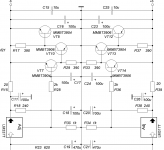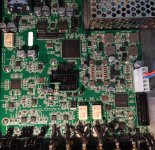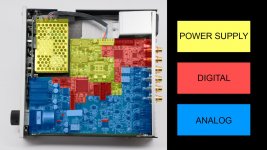Wima mks4 with the following values in parallel to ground for each rail: 10+10+22+33+33 (all values in uf). So far, the particular combination seems pretty close to a sweet spot. Using all 33uf caps audibly results in slightly reduced sound quality. Perhaps the bigger caps have too much ESR and or ESL at higher audio frequencies.
EDIT: People have reported hearing improved sound quality with as little as 15uf of smaller parallel film caps per rail, but unknown if that is sufficient for best results. Also, that was tried with another dac, not Katana.
EDIT: People have reported hearing improved sound quality with as little as 15uf of smaller parallel film caps per rail, but unknown if that is sufficient for best results. Also, that was tried with another dac, not Katana.
Last edited:
xrk, I suppose your shown power supply above in the application you mention do not directly feed gain stages etc but there will be downstream LDO etc before you hit the "real deal"?
//
The data shown above doesn't have the VR in place - actually just 12v Class 2 feeding DC-DC step up, feeding cap Mx, then CRCRC. But I almost forgot that I indeed have data from a system where I made a custom dual rail supply for a HPA. It uses 12v Class 2 feeding dual rail +/-24v DC-DC, feeding TPS7Axxx LDO regs, then a cap Mx, then a CRCRC. It has amazing performance. Thread here:
Simple High Performance DC Coupled Class A HPA with sub PPM THD
Here is that PSU:
Here is the measured FFT for this wall-powered HPA that is DC-coupled (hence the rising noise-floor in the bass region):
You can see that the noise floor hash is really minimized - that's the TPS7Axxx doing its job.
So, this variant has all the bells and whistles thrown in. The simple PSU board in the GB doesn not have built in DC-DC or CRCRC but that can be added by user easily enough, on as needed basis. The above PSU pieces and parts add up though as the dual rail 24v DC-DC was $45, the TO220 LDO's were $12ea, then the rest of the parts and pieces add up to about a $80 total price. But the performance you get is "battery-like" from a wall plug powered source. I don't think I have ever measured a cleaner mains-powered amp before. For context, the total HPA is shown below - I gave it to Byrtt, so you might want to ask him how quiet it sounds.
Last edited:
63v are what I used. Don't think 50v or 100v matters much, but physical size and cost may work out best with 63v.
That summed to 100USD for my need so, no
I do run L304x stabs so I'm good
//
Last edited:
In the view of a number of people who have compared, LT304x sucks for dacs. ADM7150 or ADM7154 is what some people have had good success with for something like Sabre AVCC supplies, but those LDOs are low voltage. Twisted Pear sells a shunt regulator PS for their +-15v dac power needs. Haven't tried it, but their designs have gone through a number iterations and probably getting pretty good.
EDIT:
Hey there is a Nazar regulator that is cheap and easy! Will post schematic below.
In addition, I can paste some notes I was given by 'eziitis' for using it:
"the shunt transistor type depends on how much power it should deal with, so current set by R15/39 and output voltage. their value can be calculated R=(1.25-Ueb)/(0.3/Uout)+Iload
Ueb typically 0.65V, 0.3 stands for the max wattage of the transistor in this case. so if one wants to pump more current then something like BD139/140 should be used. LMs need some 4V overhead, and the whole thing radiates a little heat. anyway, the noise is in uV range, but the impedance is what rules. elcaps better not very low ESR, the reg may start to oscillate. ceramics perhaps better np0, but i am fine with x7r so far."
EDIT:
Hey there is a Nazar regulator that is cheap and easy! Will post schematic below.
In addition, I can paste some notes I was given by 'eziitis' for using it:
"the shunt transistor type depends on how much power it should deal with, so current set by R15/39 and output voltage. their value can be calculated R=(1.25-Ueb)/(0.3/Uout)+Iload
Ueb typically 0.65V, 0.3 stands for the max wattage of the transistor in this case. so if one wants to pump more current then something like BD139/140 should be used. LMs need some 4V overhead, and the whole thing radiates a little heat. anyway, the noise is in uV range, but the impedance is what rules. elcaps better not very low ESR, the reg may start to oscillate. ceramics perhaps better np0, but i am fine with x7r so far."
Attachments
Last edited:
There is a way to make ESS or AKM sound good enough to get rated A+ recommended by Stereophile, and rated SOA in measured performance. I have been closing in how how that works, and have one more problem left to look into solving.
I have been chronicling the journey in the 'ES9038Q2M board' thread:
https://www.diyaudio.com/forums/digital-line-level/314935-es9038q2m-board-373.html#post5675352
The last piece of the puzzle is an external FPGA interpolation filter. Starting to think about implementing that piece.
I have been chronicling the journey in the 'ES9038Q2M board' thread:
https://www.diyaudio.com/forums/digital-line-level/314935-es9038q2m-board-373.html#post5675352
The last piece of the puzzle is an external FPGA interpolation filter. Starting to think about implementing that piece.
I have tried Nazar and in general, find that shunt regulators cannot achieve performance of a simple DC-Dc followed by a cap Mx. For powering steady current devices like DACs and preamps, low ouput impedance that shunt regs provide is not needed. Look at the FFT of a shunt regulator and see what the mains 50/60Hz peak is.
The way to look at the problem is this: 50/60Hz and its harmonics are in the very audible human hearing range. Take a DC-DC to move that fundamental up beyond human hearing circa 200kHz or 400kHz where very steep and compact passive filters can be used to stomp that down. Then add some additional ripple regulation with a cap multiplier. Add a low noise VR to really clean it up.
With a shunt regulator and linear supply input, you are asking the shunt transistor to remove in band noise to inaudible levels. What is a typical ripple regulation from a shunt regulator? The best are no more than -60dB. A CRCRC before the shunt will get you to -80dB or so. That's a lot of work to remove that 0dB 60Hz spike.
Shift that 60Hz spike with a DC-DC converter and now the residual at 60Hz is a lot less and when you add -50dB of ripple reduction from a cap Mx, you arr at sub -100dB noise levels from the mains.
The way to look at the problem is this: 50/60Hz and its harmonics are in the very audible human hearing range. Take a DC-DC to move that fundamental up beyond human hearing circa 200kHz or 400kHz where very steep and compact passive filters can be used to stomp that down. Then add some additional ripple regulation with a cap multiplier. Add a low noise VR to really clean it up.
With a shunt regulator and linear supply input, you are asking the shunt transistor to remove in band noise to inaudible levels. What is a typical ripple regulation from a shunt regulator? The best are no more than -60dB. A CRCRC before the shunt will get you to -80dB or so. That's a lot of work to remove that 0dB 60Hz spike.
Shift that 60Hz spike with a DC-DC converter and now the residual at 60Hz is a lot less and when you add -50dB of ripple reduction from a cap Mx, you arr at sub -100dB noise levels from the mains.
It takes a two stage linear regulator to control ripple.
Also, in terms of performance it depends on what one is aiming for. High end audio design should include both measurements and careful blind listening tests. The reason people use shunt regulators for audio is because they sound better in listening tests, including blind tests. There was a article published in Linear Audio that compared detailed measurements and listen tests for voltage regulators. I would recommend to have a look at it, doesn't cost much to get just one article there. Linear Audio | your tech audio resource
Regarding SMPS for audio, I have never seen a simple low cost implementation that doesn't have low level audible hash when powering a dac. Maybe there is one, and maybe it has the necessary other attributes besides low noise, but so far the only good one I have seen is in the $2,200 Benchmark DAC-3. With enough engineering, it is certainly possible. A picture below illustrates the complexity.
Also, in terms of performance it depends on what one is aiming for. High end audio design should include both measurements and careful blind listening tests. The reason people use shunt regulators for audio is because they sound better in listening tests, including blind tests. There was a article published in Linear Audio that compared detailed measurements and listen tests for voltage regulators. I would recommend to have a look at it, doesn't cost much to get just one article there. Linear Audio | your tech audio resource
Regarding SMPS for audio, I have never seen a simple low cost implementation that doesn't have low level audible hash when powering a dac. Maybe there is one, and maybe it has the necessary other attributes besides low noise, but so far the only good one I have seen is in the $2,200 Benchmark DAC-3. With enough engineering, it is certainly possible. A picture below illustrates the complexity.
Attachments
Last edited:
Maybe you could try my inexpensive proposal of a $10 Class 2 wallwart followed by a $7DC-DC, followed by a $20 cap Mx and LDO. You might be surprised - there is no hash.
Also, if you haven’t noticed - Jan Didden recommends SMPS for the most critical low noise applications. The Silent Switcher.
The SilentSwitcher | Linear Audio NL
Also, if you haven’t noticed - Jan Didden recommends SMPS for the most critical low noise applications. The Silent Switcher.
The SilentSwitcher | Linear Audio NL
Last edited:
I understand about low noise. I have Jan's Silent Switcher. Don't recall hearing hash produced by it (or it was a very low level for me to hear under the conditions), but it did pass a lot of hash from the wall wart to the dac, maybe conducted ground noise. Traced the noise source with a shortwave radio with external wire antenna. Hash from the wall wart was up around 1MHz-3MHz. The RF went right through Silent Switcher, somehow or other. It adversely affected dac sound quality, but Silent Switcher was okay if fed from an linear supply. I stopped using it due to it having some instability with some loads.
It probably would have needed film caps too, but never tested it for that back when I was using it.
It probably would have needed film caps too, but never tested it for that back when I was using it.
Last edited:
That’s what the CLC between the SMPS and cap Mx is for - to block that hash.
Okay, that's a good thing, but there are still things that aren't clear. A differential mode filter does not necessarily eliminate common mode noise problems, for example. Maybe you could include a USB cable with ferrite clamps near the wall wart end, etc. Also, still not clear how it sounds when used for audio because noise is not the only parameter that matters. When ultra-low noise LDOs came out, everybody was so impressed by the numbers they forgot about other power supply performance parameters, like output impedance vs frequency and transient response (in case there is enough nonlinearity to make those things effectively non-equivalent).
That's Benchmark DAC-3 all right. You recognize the SMPS as a particular Meanwell?
Layout diagram below.
Aha - saw 2012 on the board - didn't think it was that old. No, looking at it now my smps has 5 screw terminal. But maybe its the only the same shielding housing. Could be anything really...
//
These folks now claim to have "Best 5V Linear" for the Raspberry Pi based on a new Ti chip : Mambo Power Supply for Raspberry Pi boards - Collybia.com
"With the new ultra noise Ti chip, which has the capability for 5V – 3A output (for the first time), we eliminate every noise from power field, in addition.
Αnd we are sure that the music community has been waiting for it for many years"
"With the new ultra noise Ti chip, which has the capability for 5V – 3A output (for the first time), we eliminate every noise from power field, in addition.
Αnd we are sure that the music community has been waiting for it for many years"
- Status
- This old topic is closed. If you want to reopen this topic, contact a moderator using the "Report Post" button.
- Home
- Amplifiers
- Power Supplies
- Best 5V SMPS ?


